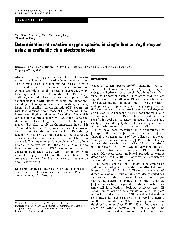摘要
Reactive oxygen species (ROS) are known to not only mediate the damage of cellular constituents but also to regulate cellular signaling. Analysis of ROS is essential if we wish to understand the mechanisms of cellular alterations. In this paper, a microfluidic chip-based approach to the determination of ROS in single erythrocyte was developed by using a simple crossed-channel glass chip with integrated operational functions, including cell sampling, single cell loading, docking, lysing, and capillary electrophoretic (CE) separation with laser-induced fluorescence (LIF) detection. Non-fluorescent dihydrorhodamine 123 (DHR 123), which can be oxidized intracellularly by ROS to the fluorescent rhodamine 123 (Rh 123), was used as the fluorogenic reagent. The effect of pH on the migration time of Rh 123 and detection sensitivity was discussed. The present method minimized dilution of intracellular ROS during reaction with DHR 123 and determination. As a result, an extremely low detection limit of 0.8 amol has been achieved. The time required for complete analysis of one human erythrocyte was less than 3 min. A migration time precision of 4.1% RSD was obtained for six consecutively-injected cells. Upon stimulation with 4 mmol/l H2O2 for 10 min, the intracellular ROS concentration was found to increase on average by about a factor of 8.4.
- 出版日期2005-8
- 单位浙江大学
